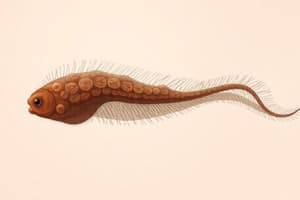Podcast
Questions and Answers
What is Fasciola hepatica commonly known as?
What is Fasciola hepatica commonly known as?
- Blood fluke
- Intestinal worm
- Heartworm
- Liver fluke (correct)
What is the habitat of Fasciola hepatica?
What is the habitat of Fasciola hepatica?
Bile duct of liver
How do humans get infected by Fasciola hepatica?
How do humans get infected by Fasciola hepatica?
Eating aquatic plants with encysted metacercariae
What is the definitive host for Fasciola hepatica?
What is the definitive host for Fasciola hepatica?
What is the intermediate host for Fasciola hepatica?
What is the intermediate host for Fasciola hepatica?
What is the infective stage of Fasciola hepatica?
What is the infective stage of Fasciola hepatica?
What is the diagnostic stage of Fasciola hepatica?
What is the diagnostic stage of Fasciola hepatica?
How long after infection does Fasciola hepatica begin to produce eggs?
How long after infection does Fasciola hepatica begin to produce eggs?
What shape do Fasciola hepatica adults have?
What shape do Fasciola hepatica adults have?
What is the size range of Fasciola hepatica eggs?
What is the size range of Fasciola hepatica eggs?
Where is Fasciola hepatica commonly found geographically?
Where is Fasciola hepatica commonly found geographically?
Transmission of Fasciola hepatica occurs through the ingestion of raw, fresh water vegetation.
Transmission of Fasciola hepatica occurs through the ingestion of raw, fresh water vegetation.
Match the symptoms to their respective phases of Fasciola hepatica infection:
Match the symptoms to their respective phases of Fasciola hepatica infection:
Flashcards are hidden until you start studying
Study Notes
Fasciola hepatica Overview
- Also known as the liver fluke, a parasitic flatworm from the Trematoda class within the Platyhelminthes phylum.
- Causes fascioliasis, impacting various mammals, including humans, with significant economic losses in livestock like sheep and cattle.
Habitat and Hosts
- Primarily inhabits the bile duct of the liver.
- Definitive hosts include sheep, cattle, and humans, while the intermediate host is fresh water snails (genus Lymnaea).
Transmission and Infection Route
- Infection occurs when mammals ingest aquatic plants contaminated with encysted metacercariae.
- Common transmission through consuming raw, fresh water vegetation or infected animal liver, particularly in the Middle East (halzoun).
Life Cycle of Fasciola hepatica
- Adults live in the liver's bile ducts and start laying eggs 2-4 months post-infection.
- Eggs hatch into miracidiae, which must find a snail host within 24 hours to survive.
- Inside the snail, miracidiae transform into rediae, which develop into cercariae.
- Cercariae encyst on aquatic plants, forming metacercariae, consumed by mammals, leading to infection in the small intestine.
Morphological Characteristics
- Adult flukes are leaf-shaped, measuring 2-3 cm in length, equipped with oral and ventral suckers, a branched caecum, and a coiled uterus.
- The genital formula includes one ovary and two testes.
Eggs and Diagnostic Features
- Fasciola hepatica eggs are unembryonated, with a thin shell, operculated, and range from 130-150 µm by 63-90 µm, serving as the diagnostic stage.
Geographic Distribution
- Widespread in rural areas, particularly in regions with cattle and sheep herding, affecting nearly 180 million people globally, with 2.4 million already infected.
Clinical Symptomatic Stages
- Symptoms can be categorized into four stages: Acute Phase, Chronic Phase, Halzoun, and Ectopic Infection.
Acute Phase Symptoms
- Rare in humans, symptoms may include fever, hepatomegaly, abdominal pain, vomiting, diarrhea, and anemia.
Chronic Phase Symptoms
- More prevalent, characterized by biliary colic, abdominal pain, hepatomegaly, jaundice, and severe anemia in children.
- Long-term inflammation can cause fibrosis and "pipestem liver," potentially leading to death.
Halzoun and Ectopic Infections
- Halzoun occurs when consuming infected raw liver, causing pain, edema, and respiratory issues; the infection can persist for up to 10 years.
- Ectopic infections are rare, affecting the peritoneal cavity, intestinal wall, lungs, or subcutaneous tissues.
Pathology and Clinical Symptoms
- Damage caused by the flukes results from their migration through liver tissues, feeding on cells and blood.
- Inflammation and edema in bile ducts are common due to the presence of the adult worms.
Studying That Suits You
Use AI to generate personalized quizzes and flashcards to suit your learning preferences.




